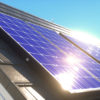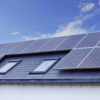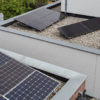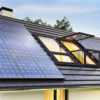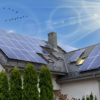In the grand scheme of all things solar, the PV panels are easily the star of the show. They’re what produce the electricity, and are the most visible part, after all.
But, there’s a lot of behind the scenes equipment that actually makes them useful. Chief among them is the inverter. It’s what converts the raw DC electricity from your panels into usable AC power.
Suffice to say, the inverter is a crucial part of your solar investment, and one you shouldn’t just gloss over. Here’s all you need to know about the types of solar inverters.
How are Solar Inverters Different From Regular Inverters
You may be tempted to go with a regular inverter when purchasing a photovoltaic power system. They are cheaper and do the same thing, after all.
But, solar power inverters have some features that make them ideal for the task at hand. Solar inverters have specific solar charge controllers and automatic transfer switches that their regular peers don’t have. These features allow the inverter to better control the flow of electricity, thus keeping faults at a minimum.
Solar inverters also come in two flavors — String Inverters and Micro-Inverters. Neither are inherently better than the other so, it’s best to consider both before buying.
String Inverters
Your solar panels come arranged in strings, i.e. one panel after another. A string inverter as the name would suggest, can hook up with 6-12 panels at a go. These present numerous advantages.
Firstly, string inverters are the most cost-effective solution available. Since all your panels are supplying to a single inverter, you needn’t invest in additional hardware. Being a simpler setup, string inverter based systems experience fewer faults and are very easy to maintain as well.
But, they’re not without drawbacks. Systems working on string inverters are forced to operate at the lowest performing panel’s output levels. So, if part of the panel ends up in a shade, then the output of all the panels in the string will drop to that of the lowest performer.
String inverters have short service life as well, with most options offering warranties of 8-12 years. You can’t monitor the performance of each panel either, as the output from the entire system is treated as one.
Finally, string inverters aren’t rapid shutdown friendly. So, if you live in an area requiring (or are desirous of having) rapid shutdown, then additional equipment will be required.
Microinverters
A microinverter is a small, plug and play device that is rated to manage the output of a single panel, between 190-220 Watts. Because of its small size and lower power management requirements, microinverters don’t have the same problems faced by the larger, string inverters.
They don’t need a large transformer, and can work with thin film capacitors. This means microinverters enjoy service lives far longer than string inverters. Most microinverters come with 25 year warranties.
Furthermore, since a microinverter goes onto a single panel, the overall output of a solar power system isn’t dependent on the lowest common denominator. Each microinverter isolates the output of its solar panel and extracts the highest voltage possible to achieve grid-parity. In other words, the entire solar power system produces the highest power output at all times regardless of prevailing sunlight conditions.
Because microinverters operate independently, system expansion isn’t an issue either. Panels of varying outputs can be safely added to the string at a later date.
But, microinverters have their own share of drawbacks. Firstly, since each panel requires a separate inverter, the initial cost of the solar power system goes up significantly. Typically, microinverters cost 5%-25% more than string inverters.
Next, microinverters may create maintenance hurdles as it can be hard to locate a fault given the number of nodes. Replacing the inverter is a challenge as well since your solar installer will need to remove the solar panel with the defective inverter.
Which One to Go For
Unfortunately, there’s no one correct answer here. Both string and micro inverters can be ideal solutions depending on the requirement. So, if cost is a consideration, then string inverters can foot the bill very well.
Also the real disadvantage of string inverters, i.e. defaulting to the lowest power point tracking only presents itself in shade. But, this can be safely sidestepped by selecting the best possible installation space.
While microinverters indeed have a higher first-time cost, it’s worth noting that replacing them can be more costly as well. Some microinverters may experience performance degradation in extreme heat, too.
Concluding Thoughts
Even though string inverters remain the most popular choice, in times to come, microinverters may become the norm.
Some manufacturers have started coming out with AC panels which are essentially panels with inverters built right into them. But, these command a higher price than their standalone versions.
Talk to a bidmysolar™ consultant to find the best fit for your needs. The bidmysolar™ platform is specifically designed to ensure that you can obtain multiple quotes across comparable brands and configurations, ensuring you have a greater choice and the best prices available.

